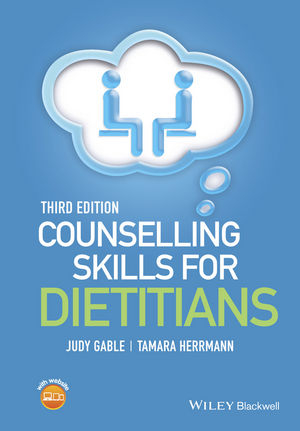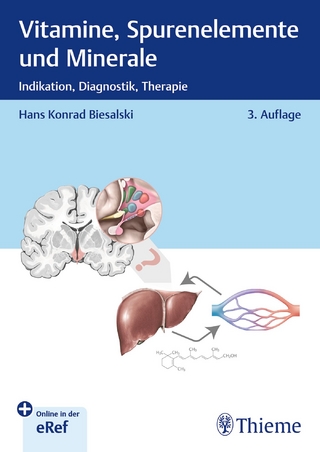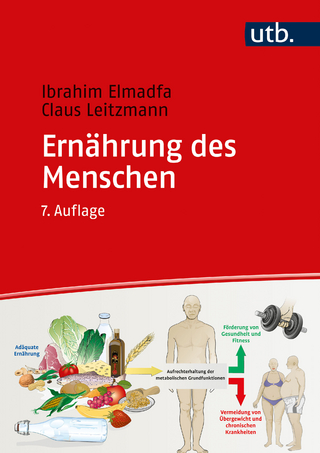
Counselling Skills for Dietitians
Wiley-Blackwell (Verlag)
978-1-118-94380-9 (ISBN)
The third edition Counselling Skills for Dieticians has been fully revised and updated to reflect the recent developments, research and interests in the field. It explores the skills required for dietetic counselling, and includes frequent examples of dialogue from patient consultations, as well as exercises and activities so that the reader can undergo experiential learning relevant to their practice.
Includes examples from daily practice to illustrate the difficulties encountered by dietitians and demonstrate the application of counselling skills
Clearly explains theoretical models of accepted counselling practice underpinning the skills described
Has been updated to include additional information on topics such as assertiveness skills and eating distress
Addresses practical and psychological issues faced by dietitians and patients
Includes the latest research evidence for counselling skills in dietetic practice
Draws upon research evidence, theory and experience from the fields of psychotherapy and counselling
Now provides access to a range of supportive online material including videos of consultations, case studies and resources for trainers
Judy Gable worked as a dietitian for many years, specialising in paediatrics in the 1970s and diabetes research in the 1980s. In the early 1990s she established the course in communication skills for dietetic students at King’s College and during the next ten years also facilitated introductory courses in counselling skills and assertiveness for dietitians. She continued to work as a counsellor in primary care until 2010. Tamara Herrmann has worked for many years as a GP/Community dietitian and during this time developed her interest in obesity, eating disorders and communication skills. Tamara now works in private practice as a registered dietitian and registered psychotherapist.
Foreword xiv
About the authors xvi
Preface to the third edition xvii
Acknowledgements xx
Introduction xxi
About the companion website xxv
Part 1: Using a counselling approach in patient‐centred practice 1
1 The dietitian 3
The role of the dietitian 3
Using a prescriptive approach 4
Control, compliance and responsibility 5
Changing approaches to providing health care 5
Developing a patient‐centred approach 7
Introducing counselling skills 8
Developing a counselling approach 10
Portrait of a dietitian using a counselling approach 10
Qualities for a dietitian to develop 11
Providing care 12
Personal and professional development 12
Self‐awareness 13
Frame of reference 13
Self‐worth 13
Reflective practice 14
Benefits of reflective practice 14
Use of the word ‘reflection’ 15
Different approaches to counselling and psychotherapy 15
Psychoanalytic approach 15
Behavioural and cognitive approaches 16
Humanistic approach 16
Transactional Analysis 17
Systemic therapy 17
Neuro‐linguistic programming 17
Mindfulness 18
Overview of the evidence concerning the use of communication skills in dietetic practice 18
References 19
2 The patient 22
Using a patient‐centred approach 22
The concerns of the patient 23
The feelings of the patient 24
The expectations of the patient 25
The nature of change 26
Change has a ripple effect 26
Change occurs in a number of ways 26
People react and adapt to change in various ways 27
Change is paradoxical, in that we both want it and do not want it 27
Change can have implications of which we are not aware 27
Reactions to change 27
Shock 28
Release of emotion 28
Talking about it 28
Ambivalence 29
Bargaining 29
Doubt about being able to cope 29
Blame 30
Distancing 30
Adapting to change 30
Patient satisfaction 31
References 32
3 The relationship between dietitian and patient 33
Circumstances surrounding the dietitian’s relationship with the patient 33
Core conditions for a helping relationship 34
Empathy 34
Acceptance 37
Genuineness 39
Issues arising between patient and dietitian: power, dependency, transference and counter‐transference 40
Power 40
Dependency 41
Transference and counter‐transference 41
The working alliance 42
A therapeutic bond 42
Goals 43
Tasks 43
Further points to consider 44
References 44
4 Aspects of the helping process 45
The dietitian’s concerns 46
Keeping boundaries: how the dietitian can manage time, confidentiality and referral 46
Establishing a time boundary 47
Maintaining confidentiality 47
Recognising professional and personal limitations: when, how and where to make a referral 50
Recognising the different developmental stages of the helping process 51
Stage 1: Listening to the patient’s story 51
Stage 2: Clarifying what the patient wants 52
Stage 3: Planning ways to achieve goals 54
Looking at the psychological process of change 55
Putting it into practice 55
Coping with ambivalence 57
Incorporating systemic awareness 58
Examples of questions to ask about diet and the home situation 59
How to end 59
Support for the dietitian 61
References 61
5 Conducting a structured interview 62
A framework for the interview 62
Beginnings 63
The interview setting 63
Preparing to provide a helping relationship 64
Opening the interview 65
Forming first impressions 65
Making introductions 68
Finding a starting point 68
Middles 69
Setting the agenda 69
Assessing motivation 71
Making a contract 72
Taking a diet history 73
Giving dietary advice 75
Monitoring the relationship 79
Endings 81
Acknowledging the ending 81
Summarising what has taken place 81
What next? 82
Saying goodbye 82
After the interview 83
References 84
Part 2: The skills 85
6 Active listening 87
The process of listening 87
Attending: a way of demonstrating acceptance 88
Attending is giving someone our attention as fully as we can 88
A listener who conveys acceptance is someone who is safe to talk to 89
Barriers to attending 90
Eye contact 90
Environment 90
Events and emotions 90
Echoes within 91
Attending to non‐verbal communication 91
Voice 91
Eye contact 92
Facial expression 92
Appearance 93
Posture 93
Gesture 93
Discrepancies and incongruities 93
Developing powers of observation 94
Distinguishing between observation and interpretation 94
Managing silences 95
Mirroring 96
Touching 97
References 98
7 Ways of responding 99
The effects of responding 99
Types of response 100
Low‐risk responses 101
Moderate‐risk responses 101
High‐risk responses 101
Very high‐risk responses 103
Self‐disclosure 103
The purpose behind a response 104
The power of language 105
Use of ‘we’, ‘you’ and ‘I’ 105
Language of success or failure 106
Language of doubt 106
Language of negativity 106
Reflective responding 107
The technique of reflecting 108
The skill of reflecting 109
Focusing on feelings 111
Mirroring language 112
When to use reflective responding 113
When reflective responding is not helpful 113
References 114
8 Making helpful interventions 115
Moving towards a helping conversation 115
Helpful interventions 116
Examining attitudes 117
Providing the core conditions when making a helpful intervention 118
Timing and level of intervention 119
Ways to intervene 121
Asking questions 121
Open questions 122
Closed questions 123
Highlighting paradoxes, discrepancies and inconsistencies 123
Confronting absolutes 123
Choosing a focus 124
Addressing sensitive issues 125
When the dietitian does not believe the patient 125
Helping someone towards clearer thinking using CBT 126
Recognising thoughts and distinguishing them from feelings 126
‘What’s going through your mind when you think that?’ 126
References 130
9 Conveying a clear message: assertiveness in action 131
Counselling skills and assertiveness 131
What is assertive communication? 132
Developing assertiveness 132
Self‐awareness and assertiveness 132
Self‐esteem and assertiveness 133
Communicating feelings 133
Aggression 133
Passivity 134
Manipulation 134
Advantages and disadvantages of assertiveness 134
Advantages 134
Disadvantages 135
Delivering a clear message 135
Preparation and reflection 135
Rehearsal 135
Delivery 135
Examples of assertiveness skills in practice 136
With a patient 136
With a GP practice manager 137
Confronting difficult situations 138
Confrontation from a colleague 139
Confrontation from a patient 139
Confronting a patient 140
Confronting a colleague 141
Handling criticism and praise 142
Criticism 142
Praise 144
Support with handling criticism and praise 145
Dealing with aggressive behaviour 145
Assessing risks 146
Taking care of yourself 146
Defusing the situation 147
Be A DEFUSER 147
Coping with the after‐effects 148
An ABC for conveying a clear message 148
References 150
Part 3: Putting skills into practice: further considerations 151
10 Working with more than one person 153
When others are in the room 153
Reasons for others to be present 153
Context of the interview 154
Risks and benefits of involving another person 154
Issues to consider when others are present 155
Dynamics between those present 155
Agendas of those present 156
Relationships between those present 156
Language and culture of those present 157
Maintaining equity and creating structure and boundaries 158
Maintaining equity 158
Creating structure and boundaries 159
Family meetings 159
Example 160
Who is responsible for finding a solution? 161
Who is leading the consultation? 161
Group work 162
Group size 162
Group demographics 162
Group dynamics 162
Group process 163
Using counselling skills with a group 164
References 165
11 Coping with loss and bereavement 166
How loss concerns dietitians 166
The need to grieve 168
Our reactions to grief 168
The process of grieving 168
How the dietitian can help 169
Loss of weight: a loss or a gain? 171
Loss of self‐esteem 171
Loss of health: living under threat of death 172
Loss of appetite 173
Support for the patient and the dietitian 174
References 175
12 Developing cultural awareness 176
What is culture? 176
Cultural changes within dietetics and the NHS 177
Move away from tradition and hierarchy 177
Prevention of disease and the rise of nutrition 178
Growth of the profession and an increase in diversity 178
Introducing a patient‐centred approach 179
Evidence‐based practice and CPD 179
Stress from change and limited resources 180
Developing cultural awareness 180
Prejudice and its development 181
Attitudes and expectations 182
Effect of prejudice on the helping relationship 182
Towards more effective communication 183
Example 183
Making introductions and establishing credentials 183
Language 184
Boundaries and goal setting 185
Social rituals and customs 186
Making effective use of an interpreter 186
Who is the interpreter? 186
Preparing for the interview 187
Working with an asylum seeker 188
Coping with difficulties 188
Ways of building bridges 188
References 189
13 Working with parents and children 190
Challenges for the dietitian 190
The needs of the child 191
Meeting the family 192
Background 192
Interview 192
Reflections 193
Considerations 193
Making a plan 194
Next meeting 194
Summary of how Sue worked with Peter 195
When a child withdraws 195
Guidelines for handling this situation 196
The angry child 196
Guidelines for handling this situation 196
The well‐behaved child 197
Guidelines for handling this situation 197
Overprotective parents 197
Guidelines for handling this situation 198
Aggressive parents 198
Guidelines for handling this situation 198
The absent parent 198
Guidelines for handling this situation 199
The dying child 199
Guidelines for handling this situation 199
Reference 200
14 Working with difficulties in physical and mental health 201
Minority needs as part of society 201
Effect on patient and dietitian 202
The patient 202
The dietitian 203
Resources for the dietitian to develop 203
Internal resources 203
External resources 204
Physical difficulties 204
Hearing 205
Sight 205
Speech 206
Mobility and movement 207
Appearance 207
Invisible disabilities 208
Mental health 208
Recognising anxiety and depression 208
How the dietitian can help 209
Helping those with eating distress: disordered eating and eating disorders 211
Hearing suicidal thoughts: how can I bear it? 217
Maintaining confidentiality when making a referral 218
References 219
Part 4: Areas for personal and professional development 221
15 Developing self‐awareness 223
Why self‐awareness is important 223
Ways to develop self‐awareness 224
Time for ourselves 224
Becoming more mindful 224
Self‐esteem 225
Ways to build self‐esteem 226
Acknowledgement 226
Tips for building self‐esteem 227
Coping with stress 227
Ways to unwind 229
Keeping a reflective diary 231
References 231
16 Giving and receiving support 233
When support is needed 233
Knowing your limits 234
Supporting yourself 235
Reflecting on practice 235
Creating a dialogue 235
Building a support network 236
Asking for support 237
Tips for asking for support 237
Giving support 238
Tips for giving support 239
Giving constructive support 239
Support from training, assessment and monitoring 240
Training in communication skills 241
Training in counselling skills 242
Supportive peer discussion 243
Making arrangements 243
Managing the session 243
Supervision 244
Personal counselling 244
What does counselling involve? 245
Who seeks counselling? 246
References 247
Index 248
| Erscheint lt. Verlag | 21.8.2019 |
|---|---|
| Verlagsort | Hoboken |
| Sprache | englisch |
| Maße | 170 x 244 mm |
| Gewicht | 567 g |
| Themenwelt | Geisteswissenschaften ► Psychologie |
| Medizin / Pharmazie ► Gesundheitsfachberufe ► Diätassistenz / Ernährungsberatung | |
| Sozialwissenschaften ► Pädagogik ► Sozialpädagogik | |
| Sozialwissenschaften ► Soziologie | |
| ISBN-10 | 1-118-94380-5 / 1118943805 |
| ISBN-13 | 978-1-118-94380-9 / 9781118943809 |
| Zustand | Neuware |
| Informationen gemäß Produktsicherheitsverordnung (GPSR) | |
| Haben Sie eine Frage zum Produkt? |
aus dem Bereich


